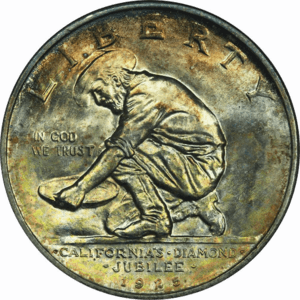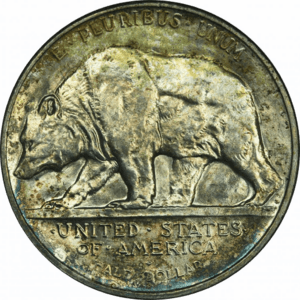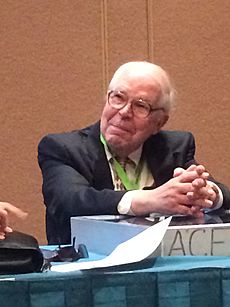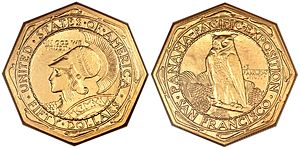California Diamond Jubilee half dollar facts for kids
| United States | |
| Value | 50 cents (0.50 US dollars) |
|---|---|
| Mass | 12.5 g |
| Diameter | 30.61 mm |
| Thickness | 2.15 mm (0.08 in) |
| Edge | Reeded |
| Composition |
|
| Silver | 0.36169 troy oz |
| Years of minting | 1925 |
| Mint marks | S (all coins). Located at the base of the reverse below the letter D in DOLLAR. |
| Obverse | |
 |
|
| Design | A Forty-Niner panning for gold |
| Designer | Jo Mora |
| Design date | 1925 |
| Reverse | |
 |
|
| Design | Grizzly bear |
| Designer | Jo Mora |
| Design date | 1925 |
The California Diamond Jubilee half dollar is a special United States commemorative silver coin. It is worth fifty cents. This coin was made at the San Francisco Mint in 1925. It was created to celebrate the 75th anniversary of California becoming a state.
A group called the San Francisco Citizens' Committee wanted to make a special coin. They planned to sell it to raise money for a big celebration. This celebration was for California's 75th birthday as a state. A California congressman helped get permission for the coin. The U.S. Congress approved it in early 1925.
The coin's designs were made by sculptor Jo Mora. At first, a group called the Commission of Fine Arts didn't like them. But the Citizens' Committee insisted on Mora's designs. In the end, they were approved. Many people have praised the coin's beauty ever since.
The coins were made in August 1925 in San Francisco. They went on sale the next month. However, they didn't sell as well as people hoped. The government allowed 300,000 coins to be made. But only about 150,000 were actually struck. Nearly half of those coins didn't sell and were melted down. Today, these coins can be worth from $200 to over $1,300. Very rare coins in perfect condition have sold for even more.
Contents
California's Early History
The land that is now California was first visited by Europeans in 1542. A Spanish explorer named Juan Rodriguez Cabrillo sailed there. His report didn't get much attention from Spain. Later, in 1579, an English sailor named Sir Francis Drake visited. This made Spain decide to colonize the area.
For the next 275 years, not many people settled in California. Most settlers lived near the missions that were built there. This was true when California was under Spanish rule and later under Mexican rule.
A coin expert named Arnie Slabaugh said that when American settlers arrived, two big changes happened in California. These changes were more immigrants (people moving in) and lots of new activities. In 1846, American settlers fought against Mexican rule. They created the Bear Flag Republic. Its flag showed a grizzly bear. This republic didn't last long. The Mexican–American War had started, and U.S. forces took over California.
In January 1848, gold was found at Sutter's Mill by James W. Marshall. This happened just a week before the Treaty of Guadalupe Hidalgo was signed. The discovery of gold led to the famous California Gold Rush. Because of all the new people and activity, California became a U.S. state in 1850.
How the Coin Idea Started
The idea for the California Diamond Jubilee half dollar came from the San Francisco Citizens' Committee. Their leader was Angelo J. Rossi. They wanted a special half dollar coin to sell. The money raised would help pay for a big celebration. This celebration was for California's 75th anniversary of becoming a state.
On January 9, 1925, a bill was introduced in the Senate. This bill was about making a silver half dollar and a gold dollar for Vermont. The Senate passed the bill, but they removed the gold dollar part. When the bill was discussed in the House of Representatives on February 16, 1925, a California Congressman named John E. Raker added something new. He suggested adding a coin for California's 75th anniversary.
This idea was strongly opposed by Representative Albert Vestal. He was the chairman of the House Committee on Coinage, Weights, and Measures. He said that the Bureau of the Mint (the place that makes coins) didn't like making "these special coins." He even said that another congressman had agreed to drop his idea for a coin honoring Fort Vancouver. But Congressman Raker kept pushing for his idea, and his amendment passed. Then, another congressman added an amendment for a Fort Vancouver Centennial half dollar. This also passed, even though Vestal was unhappy. The bill passed the House of Representatives. The Senate quickly agreed to these changes on February 17.
The Treasury Secretary, Andrew W. Mellon, asked President Calvin Coolidge to reject the bill. He wrote that the government was letting its coin system be used to make money for any celebration. He felt that even for important anniversaries, the Treasury shouldn't "debauch its currency system." He worried that each new coin would set a precedent. He believed there should be a limit to using money for special groups instead of its main purpose for business.
However, President Coolidge signed the bill. It became the Act of February 24, 1925. This law allowed all three coins to be made. This was the first time a law for special coins covered more than one coin issue. The law allowed 300,000 California coins to be made. Banks in San Francisco or Los Angeles would get the coins at their face value (50 cents) to sell for the Citizens' Committee.
Making the Coin's Design
On May 4, 1925, Angelo Rossi wrote to the Mint Director, Robert J. Grant. Rossi said there had been a delay in getting the design ready for the new half dollar. He also mentioned that California Senator Samuel M. Shortridge wanted the committee to hurry. Rossi included sketches by a California sculptor named Joseph (Jo) Mora. He promised that a finished design and a model would follow. The Citizens' Committee members had all chosen Mora. They felt he was the best artist to capture the spirit of California's anniversary.
The sketches and letter were sent to the Commission of Fine Arts. This group was in charge of giving advice on coin designs since 1921. Then, they went to its sculptor member, James Earle Fraser. Fraser was the designer of the Buffalo nickel. Fraser wrote to Rossi on May 18. He said the designs were not good. He called them "inexperienced and amateurish." He suggested hiring Chester Beach or Robert I. Aitken. Both were from California and might create something "far more interesting."
Despite Fraser's advice, the Citizens' Committee stuck with Mora. He quickly finished the sketches. Coin experts Anthony Swiatek and Walter Breen believe the committee didn't hire Beach or Aitken because they didn't have enough time or money for their high fees. The finished models were sent to the Philadelphia Mint on June 17. From there, they went to the Commission. By this time, Fraser was no longer a member. The designs were sent to Lorado Taft. A note said the Citizens' Committee didn't hire Aitken because he was too expensive. It also said the new designs were not much better than the old ones.
However, both Taft and another member, Louis Ayres, recommended approving the designs. Ayres did suggest that the motto "In God We Trust" should be placed somewhere else. He thought it looked like the "49ers were frying it in oil." Coin historian Don Taxay said this advice wasn't followed because there was no other good place for the motto.
Once the designs were accepted, the Mint made the working dies (tools for stamping coins) in July 1925. These were sent from Philadelphia to the San Francisco Mint. There, 150,000 coins were made in August. An extra 200 coins were set aside for testing in 1926.
Coin Design Details

When Mora designed the half dollar, he used images that reminded people of California in 1850. The front side of the coin, called the obverse, shows a prospector from the Gold Rush era. He is kneeling and washing material with his pan. He is looking for small pieces of placer gold. The back side of the coin, called the reverse, shows a grizzly bear. This bear is similar to the one on the Bear Flag. Mora left the background of the coin unpolished. This gave the coin a special textured look.
The California Diamond Jubilee half dollar has been widely admired. Coin expert Anthony Swiatek called it "one of my favorite numismatic works of art." Coin dealer and author Q. David Bowers said the Citizens' Committee "wisely ignored Fraser's criticism." Eric Brothers wrote in 2014 that the coin "embodied the quintessential imagery of California in the 1850s."
David M. Bullowa, who studied special coins in the 1930s, thought it was a "very strong and well-made half dollar." He also liked that the front and back designs were clearly related. Another expert, B. Max Mehl, wrote in 1937 that it was a "beautiful coin." He said the front was "a very fine piece of art." However, he thought the animal on the back was a polar bear. He was confused, saying he had "never yet seen a bear" in California.
Art historian Cornelius Vermeule called the California coin "one of America's greatest works of numismatic coinage." He thought the design was bold and effective. He especially admired the bear, saying its "muscles, bones, and tufts of fur express the massive determination of the bear." He also liked the lettering. Two different sizes of letters are used. All three common phrases on American coins are there: "Liberty," "In God We Trust," and "E Pluribus Unum." But he felt they were placed so skillfully that it was hard to notice all three were used.
How the Coin Was Sold and Collected
The very first California Diamond Jubilee half dollar made was given to the Memorial Museum in Golden Gate Park, San Francisco. The tool used to make the first coins was specially treated. This made the first 75 or so coins have a frosted or "cameo effect." This special look wore off after those first coins. Coin expert Kevin Flynn believes the first 100 coins had these special surfaces. He thinks this was done at Rossi's request for important people. One coin is known to exist without a mint mark. This was probably a trial coin owned by the Mint's Chief Engraver, John R. Sinnock.
At least one half dollar was seen outside the San Francisco Mint by August 26, 1925. It was shown at a meeting of the Pacific Coast Numismatic Society that day. Children born on California's 75th statehood anniversary (September 9, 1925) in California were given one of these half dollars. A total of 494 children received them. A few coins were put into special badges worn by officials. Many coins were sold at a celebration in San Francisco from September 6 to 12.
Thousands of coins were bought by coin collectors and dealers. But most of them are believed to have gone to people who were not collectors. According to Bowers, the sales efforts were "not particularly well coordinated." Because of this, 63,606 coins were sent back to the Mint and melted down. This means only 86,594 coins were given to the public, including the coins used for testing.
The price of the half dollar has slowly gone up over the years. The only times the price dropped were after big booms in commemorative coin collecting in 1936 and 1980. The 2015 edition of Richard S. Yeoman's A Guide Book of United States Coins lists its value between $200 and $1,300, depending on its condition. One coin, in amazing MS-68 condition, sold for $17,250 at an auction in 2009.
See also
 In Spanish: Medio dólar de las bodas de diamante de California para niños
In Spanish: Medio dólar de las bodas de diamante de California para niños


